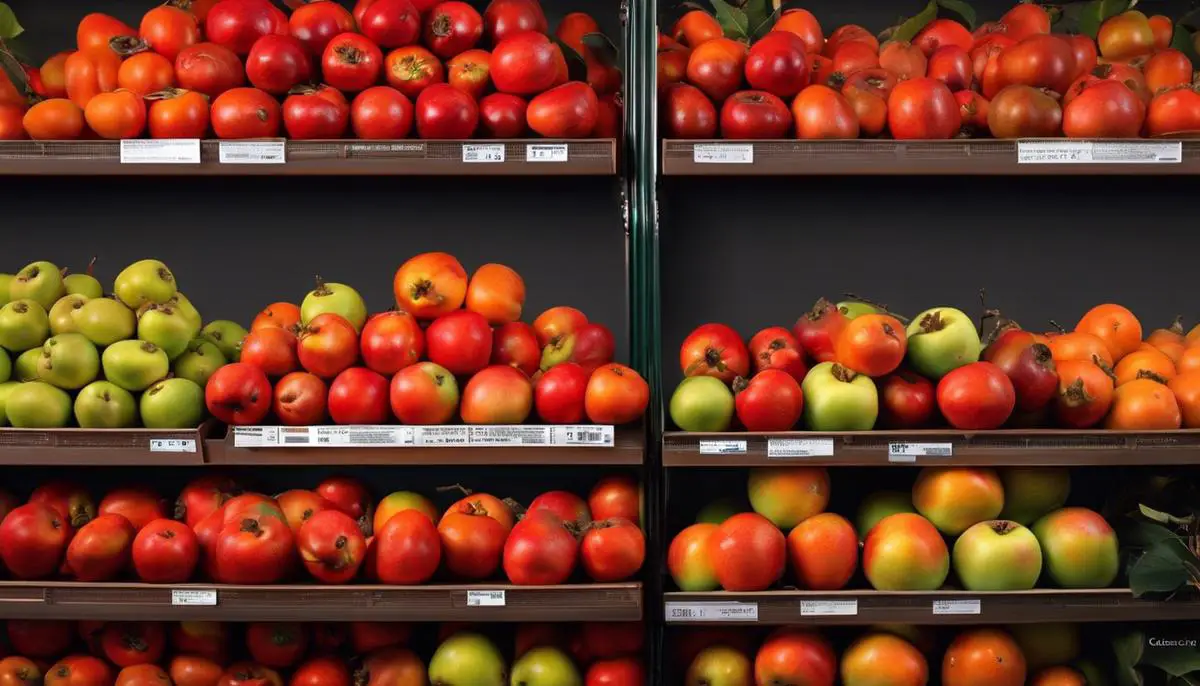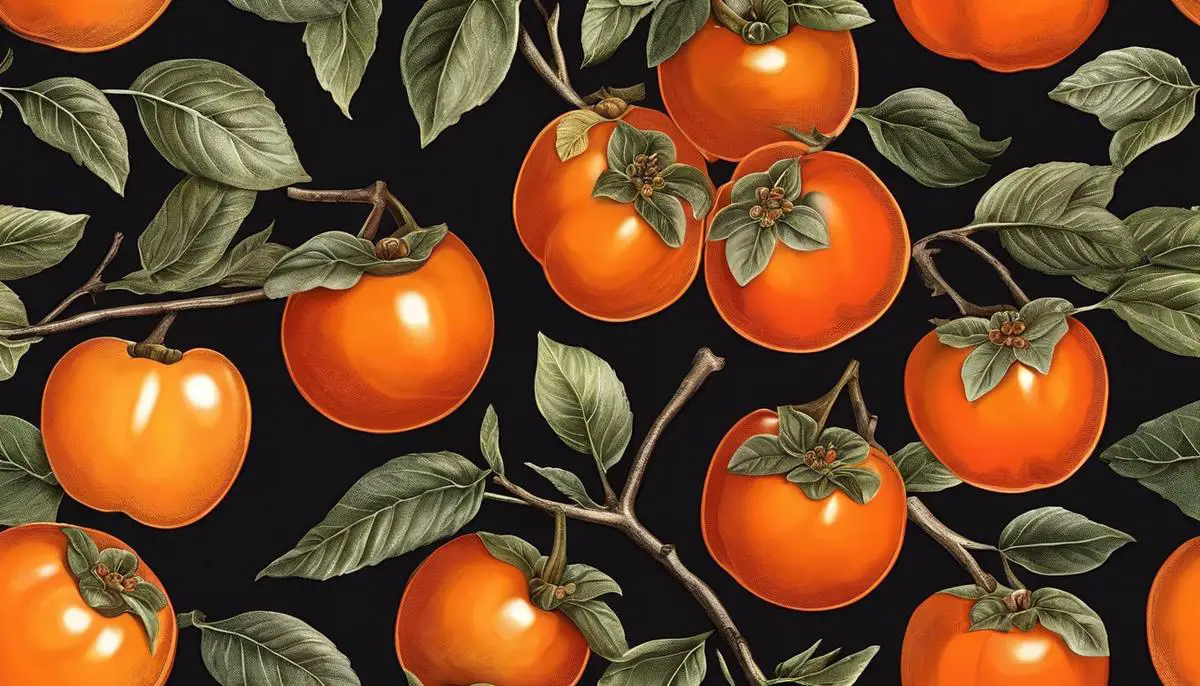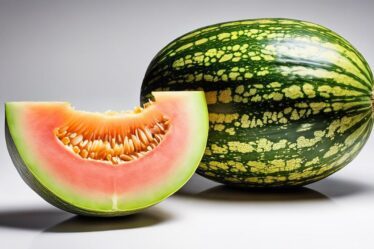
Often overlooked in the bounty of worldwide fruits, the humble yet glorious persimmon deserves our full appreciation and culinary exploration. With a mysteriously rich heritage, this gem of a fruit provides a host of tasteful surprises and complex subtleties that can enhance the way you perceive and enjoy your food. As you embark on this journey, you will discover the unique taste, texture, and visual beauty of various persimmon varieties, derived from native trees across the world. What’s more enthralling is the wealth of nutritional benefits hidden within its bright-orange or reddish skin, giving food enthusiasts even more reasons to incorporate it into their culinary endeavors.
Discovering the Persimmon
Discovering the Unexplored Joy of Persimmons
Sitting majestically on the supermarket shelves, nestled between the apples and pears, are these uniquely vibrant orange-red fruits. Oblong and slightly squat, with a leafy calyx at their head – this is the divine peach-like delight known as Persimmon.
Originating from the far corners of East Asia, Persimmons have a long history, with its roots tracing back to ancient China, then meandering through Japan and Korea, and eventually setting foot in Europe, the United States, and various parts of the tropical world. Having an illustrious past, each region has cultivated its own type based on climate and cultural diet preferences. The principal types are the non-astringent sweet Fuyu relished in China and the astringent heart-shaped Hachiya consumed in Japan.
Persimmon’s journey from eastern Asia to the western world was an arduous one, starting with Commodore Matthew Perry, who brought them to the United States in the mid-1800s, and continued by Dr. H.H. Hume, who further popularized this delightful fruit. This alluring fruit found a place in American backyards and kitchen tables, offering a salute to eastern culinary heritage and a sweet surprise for those unfamiliar with its unique flavor.
Unraveling this delicious fruit’s mystery requires a deeper understanding of its dual personality, defined by its astringency. Astringent persimmons such as the Hachiya need patience and a soft touch. They’re not palatable until fully ripe, which means they need to reach an almost jelly-like softness. Once ripe, the inside reveals a honeyed custard consistency, perfect for puddings, bread, and oriental cakes. On the other hand, the Fuyu variety can be enjoyed while still crispy like an apple and promises a remarkable crunch with a mildly sweet overtone. Either way, the persimmon is a symphony of taste ready to be enjoyed.
Diving into the health benefits, a full-ripe persimmon is a cornucopia of vital nutrients—rich in Vitamin A, Vitamin C, and fiber, it bolsters your immunity while keeping your heart healthy and weight checked.
It’s the persimmon’s unique taste, texture, and versatility that makes it a fruit worth the culinary exploration. Whether you’re simmering it into a sweet-savory sauce, baking it into a warming winter pie, or presenting it raw in a salad with artisanal cheese and nuts, the persimmon has the power to transform any dish into a delightful experience.
Think it’s high time this season to grab a persimmon, don’t you? Relish its sweet and slightly tangy flavor profile, explore its culinary versatility, and when you’re taking the first bite or spoonful, remember the cultural history this humble fruit has witnessed over centuries. This is not merely enjoying a fruit, but also partaking in a slice of ancient tradition and history – right from the confines of one’s kitchen.

Incorporating Persimmons into Your Meals
Persimmon, the bright orange-yellow fruit of fall and winter, is an underutilized asset to our diets. Given its rich history, versatile taste profiles, and numerous health benefits, the question naturally arises – how can we incorporate more persimmons in our meals? Here’s the scoop.
For starters, consider the wonderful world of breakfast possibilities. Ripe persimmons, particularly the non-astringent variety, make delightful additions to smoothies. Add them along with banana, spinach, and almond milk for a nutrient-packed shake, or coupled with tangy Greek yogurt for a hearty morning meal. Their natural sweetness is a fantastic addition to breakfast cereals, oatmeal, or muesli.
Need a snack on the run? Consider dried persimmons which, for a while, were Japan’s secret to health and longevity. Drying persimmons delivers a sweet, candy-like texture. Perfect for an energy-boosting midday snack, they can also be chopped and added to granola bars, trail mix, or even homemade muesli bars for an added healthful punch.
When it comes to main dishes, the delectable persimmon isn’t shy. Grilling brings out its natural sugars, making them a perfect companion for savoury BBQ or roast meat. Thinly sliced and raw, fuyu persimmons add a crisp sweetness to salads and ceviches, much like pears or apples. Glaze roasted pork or chicken with a tangy persimmon sauce. In vegetarian meals, roasted persimmons become an excellent partner to spicy or earthy ingredients like chilli peppers, roasted vegetables, goat cheese, and farro grain.
Now, onto the grand finale: Desserts. Persimmon pudding is a classic, certainly, but there’s no limit to the sweet creations possible! Hachiya persimmon pulp delivers a creamy flavor and moist texture to cakes, muffins, and quick bread. Non-bakers, take heart: a ripe persimmon split open and served with a dollop of mascarpone and a drizzle of honey is a sophisticated dessert in its own right.
Let’s not forget the versatility of persimmon as a beverage component – it adds a vibrant freshness to cocktails or mocktails. Blended into a refreshing smoothie or simply pressed into juice, persimmons enliven the sensory palette.
In essence, persimmons may appear exotic, but they slide into everyday cooking and eating with ease. For the hungry explorer eager harness the versatile, nutritious, and delicious power of this wonder-fruit, myriad culinary opportunities promise delightful surprises and experiences. It’s time to start adding a shimmer of persimmon gold to our diets!

Culinary Techniques and Pairings with Persimmons
Persimmons, with their sweet, tangy flavor and bright, attractive exterior, can be a beautiful and tasty addition to a variety of dishes. Whether you’re a gourmet chef or an adventurous home cook, there exist multiple culinary techniques that beautifully complement this versatile fruit.
Perfect for purees, persimmons lend themselves well to a food processor. Persimmon puree can be transformed into a delightful sauce that pairs wonderfully with all manner of meats, specifically, with subtler proteins like chicken or turkey. The sweet, honey-like attributes of persimmons balance the savory notes, creating a symphony of flavor sure to delight the palate.
Poaching is another delightful method of preparing persimmons. This technique, often used for pears and peaches, adapts well to this fruit. Poaching gently in a syrup of sugar, water and a touch of vanilla produces tender, sweet persimmons, perfect for dessert or even a side dish.
For the more adventurous culinarian, persimmons can also be pickled. Pickling adds a tangy zest to the sweet fruit and can be done in a variety of creative ways. This technique produces a unique addition to any charcuterie board, cheese platter, or salad.
Roasting persimmons is a simple yet effective method of preparation. This renders the fruit deliciously custardy, which works wonderfully as a garnish to savory entrees or as an addition to desserts.
In terms of pairings, persimmons, like most fruit, go beautifully with cream-based foods. Try creating a persimmon-infused cream sauce to pair with tender grilled chicken, or simply serve alongside a healthy dollop of mascarpone cheese for a delightful dessert.
Persimmons also pair well with bold, earthy spices such as clove, cinnamon, and nutmeg. These flavors truly bring out the natural sweetness of the fruit, while adding depth and complexity to the overall taste profile. Incorporating these seasonings in dishes with persimmons can elevate your culinary creations to gourmet level.
For a delicious savory combination, consider pairing persimmons with herbs like rosemary and mint. These fresh flavors provide a wonderful contrast to the sweet fruit, yielding a launching of taste that you’ll surely enjoy.
Finally, persimmons shine when used in combination with other fall and winter fruits, such as pears, apples, or pomegranates. Mixing these fruits in various dishes creates a harmonious blend of flavors that reflect the seasonal bounty.
Lastly, when thinking about pairings, don’t forget about the world of beverages. Persimmons are a flavorful addition to cocktails or mocktails, providing a lovely sweetness when muddled or used in a simple syrup. For a non-alcoholic spin, add fresh persimmon juice or puree to sparking water for a refreshing spritzer.
Culinary experimentation with persimmons brings forth great reward. The sheer versatility of this fruit means it’s just as at home in a savory main course as it is in a sweet, satisfying dessert – and everything in between. So don’t be afraid to let the humble persimmon take center stage in your next culinary masterpiece! Happy cooking!

Embarking on the culinary journey with persimmons not only enriches the palate but also stimulates a deeper appreciation for the pure, complex flavors nature has to offer. By recognizing the adaptability of this fruit, one can create magical combinations in sweet and savory dishes alike. Additionally, an understanding of the various techniques to cook persimmons and their strategic pairings with wine, cheese, and spices broadens the horizon for countless gastronomic adventures. So here’s to exploring and cherishing the remarkable versatility of the humble persimmon, a fruit that truly deserves its moment in the culinary spotlight.



